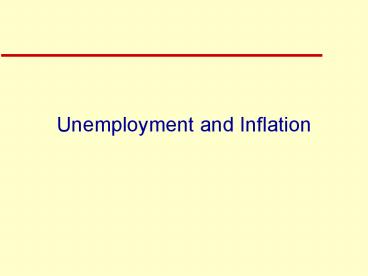Unemployment and Inflation - PowerPoint PPT Presentation
1 / 22
Title:
Unemployment and Inflation
Description:
... does the overall unemployment rate measure? What ... The Unemployment Rate ... Frictional unemployment is temporary for an individual, but it is ongoing within ... – PowerPoint PPT presentation
Number of Views:249
Avg rating:3.0/5.0
Title: Unemployment and Inflation
1
Unemployment and Inflation
2
Unemployment
- Three questions concerning the overall
unemployment rate - What does the overall unemployment rate measure?
- What are the sources of overall unemployment?
- How does overall unemployment change over time?
3
Measuring Unemployment
- Labor Force
- All noninstitutionalized civialians 16 years of
age and older who are either working or actively
looking for work
4
Three Groups of individuals
- The number of unemployed individuals expressed as
a percentage of the labor force - Employed individuals - Individuals are considered
employed if they have full time or part time
jobs. - Unemployed individuals - Individuals that are
not working, but have been seeking work within
the past 4 weeks. - Individuals not it labor force
5
The Unemployment Rate
- The number of unemployed individuals expressed as
a percentage of the labor force
6
The Labor Force Participation Rate
- The number of individuals considered as part of
the labor force divided by the number of
noninstitutionalized civilians 16 years of age
and older.
7
Sources of Unemployment
- Question
- How do people become unemployed?
8
Sources of Unemployment
- Four Types of Unemployment
- Frictional Unemployment
- Structural Unemployment
- Seasonal Unemployment
- Cyclical Unemployment
9
Frictional Unemployment
- Frictional unemployment defined
- Frictional unemployment is temporary for an
individual, but it is ongoing within the economy
as a whole.
10
Structural Unemployment
- Structural unemployment arises for 2 reasons
- Low skilled or unskilled labor.
- Chronically unemployed
- Workers need to relocate from shrinking
industries or depressed areas to areas that are
growing.
11
Seasonal Unemployment
- Seasonal unemployment is caused by seasonal
shifts in labor supply and demand
12
Cyclical Unemployment
- Cyclical unemployment occurs because of
fluctuations in the business cycle.
13
Full Employment
- Full employment is the level of employment when
there is no cyclical unemployment. - Full employment doesnt mean zero unemployment.
Why? - A 4-6 unemployment rate is considered full
employment
14
Unemployment Over Time
- Recessions and Unemployment
- Expansions and Unemployment
15
Unemployment Over Time
- Convergence in labor force between men and women
- Participation rates have risen for women from 34
to 60 since 1950 - Participation rates have declined for men from
86 to 75 since 1950. - Why have the participation rates for men and
women changed?
16
Problems with Official Unemployment Figures
- Underestimation of Unemployment Rate
- Doesnt include discouraged workers
- Doesnt include underemployment
- Part-time workers
- Overqualified workers
- Overestimation of Unemployment Rate
- Unemployment benefits
- Individuals that work and dont report their
income - Individuals that work a lot of overtime
17
Inflation
- Inflation is a sustained increase in the average
level of prices - Disinflation is a reduction in the positive
inflation rate - Deflation is a sustained decrease in the price
level (a negative inflation rate) - Hyperinflation is a very high rate of inflation
- Brazil had inflation over 1000
- Germany between WW1 and WW2
- Hungry experienced inflation over 19,800 after
the WW2
18
Demand-Pull Inflation
- A sustained rise in the price level caused by
increases in aggregate demand
Price level
AD
AD
AS
Aggregate Output
19
Cost-Push Inflation
- A sustained rise in the price level caused by
reductions in aggregate supply - The combination of inflation and a falling level
of output has come to be called stagflation
Price level
AD
AS
AS
Aggregate Output
20
Anticipated Versus Unanticipated Inflation
- Anticipated inflation is inflation that is
correctly predicted - Unanticipated inflation is the amount of
inflation that was unexpected. - A major issue is whether workers can accurately
anticipate changes in the price level - Workers seek to anticipate inflation so that the
purchasing power of wages are maintained
21
Inflation and Interest Rates
- Inflation creates a difference between real and
nominal interest rates - Nominal Interest Rate vs Real Interest Rate
- Inflation risk makes some lenders offer
adjustable-rate home loans
22
Why is Inflation So Unpopular?
- As an economic problem, inflation is widespread
- Workers wages may not keep up with inflation
- Those on fixed incomes are seriously affected
- Long-term contracts are difficult to negotiate































